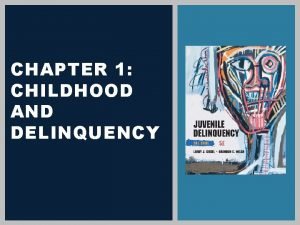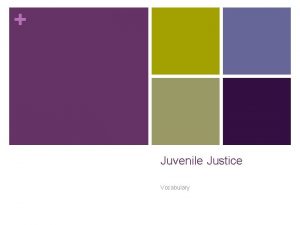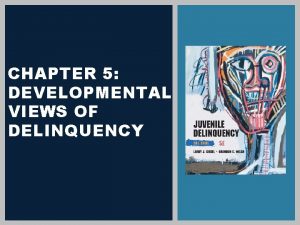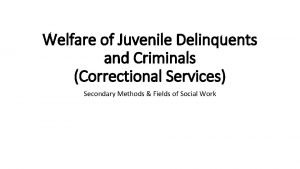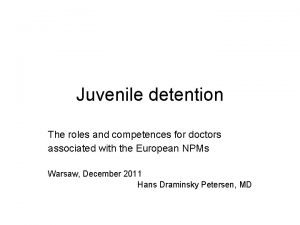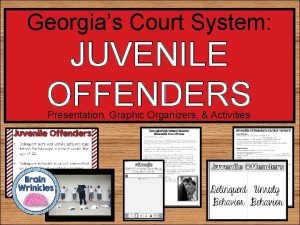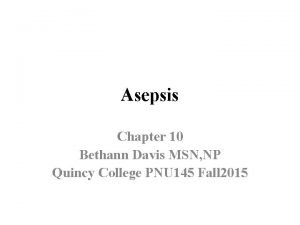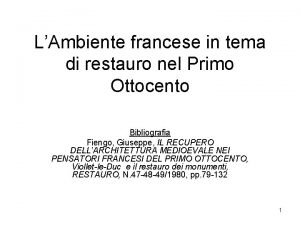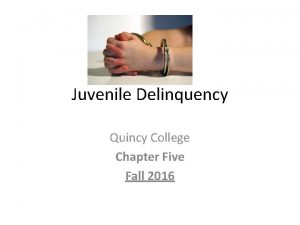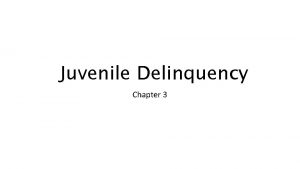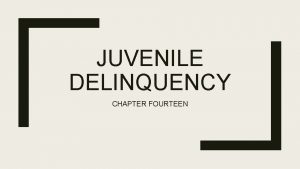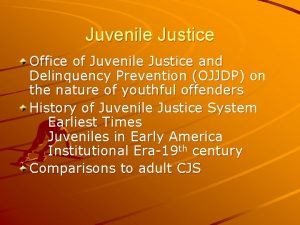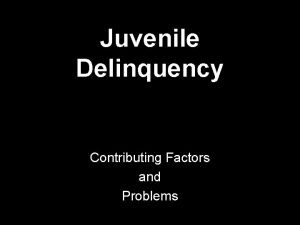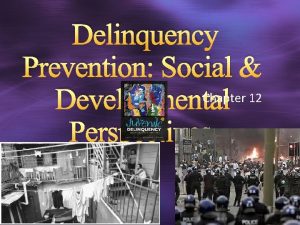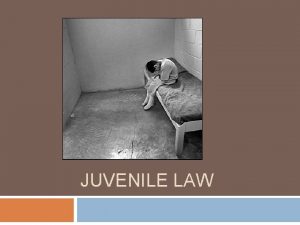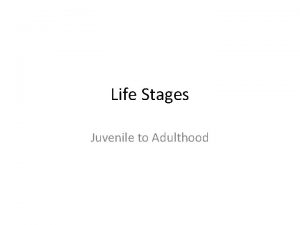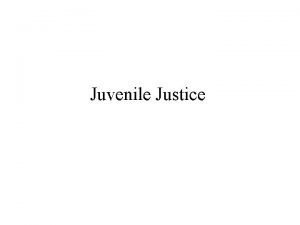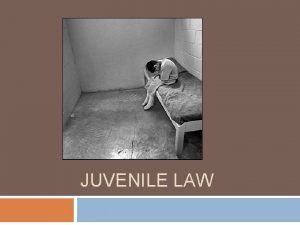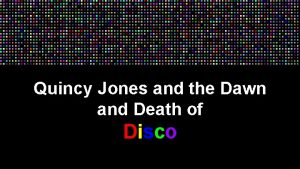Juvenile Delinquency Quincy College Chapter Six Fall 2016

















- Slides: 17

Juvenile Delinquency Quincy College Chapter Six Fall 2016

Disclaimer • The Information in this presentation is a representation of the material in the textbook of this class. It is not to be assumed that the Instructor agrees with the material, or this material represents the views of Quincy College or the Instructor. Students are encouraged to provide their feedback in relation to the material

Chapter Six Review: Social Interactionist Theories of Delinquency • Social Interactionist Theory: 1) Labeling theory 2) Interactionist theory 3) Conflict theory, derived from the concept of the give-and-take that occurs between the individual and society

Labeling Theory • Labeling Theory: Society creates delinquents by labeling juvenile offenders as different from other youths • Tannenbaum (c. 1927): Dramatization of evil. Consequence of labeling a juvenile as delinquent

Labeling • Discussion… • Does labeling matter? ? ?

More Theories…. • Lemert: Primary and secondary deviation: Interaction between social control agents and violators-Primary deviation-Individual’s (deviant) behavior, Secondary deviation. Society’s response to that behavior

More Theories…. Process of becoming deviant: • 1) Primary deviation • 2) Social penalties • 3) Further primary deviation • 4) Stronger penalties, rejection • 5) Further deviation (hostility and resentment)

Deviance • 6) Crisis reached-stigmatizing the deviant • 7) As a result, strengthening of deviant conduct • 8) Acceptance of deviant status

Labels… • Howard Becker: Rules applied to certain people, creating labeling, this leads to deviance • New Development in the Labeling Theory: Formal Labels: Labels by Official Agents • Informal Labeling: Labels by Family Friends, etc.

More Theories… • Symbolic Intervention Theory; Interaction at the symbolic level- One example may be a youth that becomes a parent • Role Taking and Delinquency: The situation can influence delinquency by presenting opportunities for delinquent behavior or the situation can effect the content and direction of social action

Conflict… • Interactionist perspectives on gender, race, and delinquency: “structural conflict gives rise to gender and race differences in motivations to break the law” • Conflict theory: Social control is the end result of the differential distribution of economic and political power in society

Class… • Sociological class and radical criminology Radical criminology is a view based of Marxism • Power and authority relationships: Social stratification related to crime • Power-control thesis: Relationship between gender and delinquency is linked to issues of power and control

Oppression • Theory of differential oppression: Authority is unjustly used against children, who must adapt to adult ideas of values and norms and organized around four principles: • Four Elements of the Theory of differential oppression: • 1) Children lack physical power and resources, as such are easy targets of adults • 2) Adult oppression of children covers many contexts from moderate neglect to severe abuse.

Oppression • 3) The oppression of children produces at least four adaptive reactions: • Passive acceptance • Exercise of illegitimate coercive power • Manipulation of peers • Retaliation • 4) The adaptation of the children reinforces adult’s view of children as inferior

Culture • Group and cultural conflicts: Conflict created by Conduct Norm actions • Conduct norms: the norms of the group or culture may differ from the norms of the greater society and the culture demands adherence to the norms of the group, not the norms of society

Justice • Restorative justice: Legal standards are not sufficient to create ethical community behavior • Community conferencing: a judicial tool making it possible for victims, offenders and the community to meet and resolve issues • Sentencing circles: One form of Community conferencing, incorporating principles of tribal justice

Questions ? ? ? • Thank You
 According to choice theorists offenders
According to choice theorists offenders Nature and extent of juvenile delinquency
Nature and extent of juvenile delinquency Juvenile delinquency objectives
Juvenile delinquency objectives Poverty and juvenile delinquency
Poverty and juvenile delinquency Cottage reformatories
Cottage reformatories Newspaper article on juvenile delinquency
Newspaper article on juvenile delinquency Developmental theory juvenile delinquency
Developmental theory juvenile delinquency Categories of delinquent youth
Categories of delinquent youth Treatment of juvenile delinquency
Treatment of juvenile delinquency Management of juvenile delinquency
Management of juvenile delinquency Juvenile offenders comprehension check answers
Juvenile offenders comprehension check answers Quincy college portal
Quincy college portal Anna baldwin milking machine
Anna baldwin milking machine Define john quincy adams
Define john quincy adams Centergize
Centergize Quatremere de quincy restauro
Quatremere de quincy restauro In quincy
In quincy Free fall 2016
Free fall 2016


